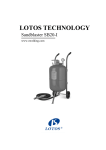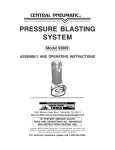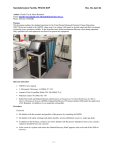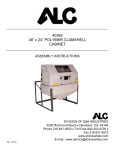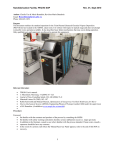Download ATD Tools ATD-8402 User's Manual
Transcript
ATD-8402 90LB PRESSURE BLASTER INSTRUCTION MANUAL SAVE THESE INSTRUCTIONS SAFETY INSTRUCTIONS FOR SANDBLASTER 1. Before opening the tank release the air pressure on the sand tank. To do this, turn off the air supply valve(#14) to release pressure in the line. Be sure that the tank pressure gauge (#05) reads zero then open the tank. 2. Maintain correct air pressure. Pressure should not exceed 125PSI. If it does, the safety valve (#06) is supposed to release the excess pressure. If it doesn’t release excess pressure, stop all work immediately and use the air compressor to reduce the excess pressure. Do not investigate the sandblaster’s pressure problem until the pressure gauge (#05) reads zero. 3. When using pneumatic equipment, basic safety precautions should always be followed to reduce the risk of personal injury and hazards due to over pressurization. 4. Do not operate the unit when tired or under the influence of alcohol or drugs. 5. When servicing only use parts and accessories intended for use with this unit. 6. Do not allow sand blaster to be pressurized while unattended or not in use. WARNING: The warnings and cautions discussed in this instruction manual cannot cover all possible conditions and situations that may occur. It must be understood by the operator that common sense and caution are factors that cannot be built into this product but must be supplied by the operator. ASSEMBLY USE PTFE tape for all threaded air connections 1. Assemble the intake manifold (#08). Attach the pressure gauge (#05) to the top of the intake manifold (#08), and turn the gauge so that it can be seen across the top of the tank. Next, attach the sand meter valve (#18) to the bottom of the manifold (#08). Attach the connector (#07A) to the bottom of the sand meter valve (#18); attach the nipple connectors (#07) to the manifold (#08). Attach the safety valve (#06) to the manifold (#08) as shown in the diagram. 2. Assemble the water trap filter (#12). Two nipple connectors (#07) are screwed into each side of the filter (#12). Attach the nipple connector (#07) to one side of air supply valve (#14); then attach the male-female connector (#15) to the other side of air supply valve (#14). When ready to operate the sandblaster, the air hose from compressor will fasten to the male-female connector (#15). 3. Place the tank (#03) on a table with four clips up. Screw the water trap filter(#12) and its parts into the hole at the side of the intake manifold. Then screw the open end of the nipple connector (#07) with intake manifold (#08) and pressure gauge (#05) attached into the threaded hole on the side of the filler pipe on top of the tank. Again, be sure that the manifold and gauge are vertical. 4. Assemble the sand outlet valve into the hole at the bottom of the tank. Attach four parts in order: 1pc Nipple Connector (#07); Sand Metering Valve (#18); the other nipple connector (#07) and the sand outlet pipe(#19). 5. Assemble the sand meter valve. Slide two hose clamps (#26) over each end of the sand hose (#25). Press one end of the hose over the nipple on the sand outlet pipe (#19) and the other end over the intake connector(#27). Both hose ends should be firmly seated on the nipples. Slide the hose clamps along the hose to each nipple and tighten the clamps firmly. They have to resist the force of 65 to 125PSI. 6. Fasten the handlebars (#02) to the tank by using pan screw (#11), washer (#10) and hex nut (#09). Fixing axle brackets (#20) on the tank by using screw (#16). NOTE: Keep the handle curve ends upward. 7. Locate axle (#23) and slide it through the holes at the sides of the axle brackets (#20). Place one wheel (#22) at each end of the axle and fasten them into place with cotter pin (#24) and washer (#21). 8. Insert the fixed foot (#17) onto the fitting on the bottom of the tank near the edge. Use the last cotter pin(#24) to hold the foot on the tank. 9. Before operating, go back over each connection, double checking to ensure that all connections are tight and properly seated. ABRASIVE SELECTION The kind of sand you choose will greatly influence the amount of time needed to clean a given surface area. Sandblasting materials include silicon carbide, alumina, silica sand, bank sand and beach sand. However, bank sand and beach sand even if washed, will still contain shell, coral and organic materials. These absorb moisture much more readily than the other material. As a result, the moisture in bank sand and beach sands frequently causes plugging of the sand meter valve. If you select to reuse sand, remember it does wear out. The sharp edges become rounder and are less effective. It’s at that point you should replace the batch of sand that you are using. LOADING ABRASIVES 1. Check abrasive to be sure it’s dry and won’t clog the meter valve (#18), sand outlet pipe (#19), sand hose (#25) or other components. 2. Put on protective clothing. 3. Turn the air supply valve (#14) to the off (horizontal) position. 4. Watch the pressure gauge (#05) and make sure it reads zero. 5. Be sure to get enough abrasive into the tank to do the job at hand. But if this is a big job, only fill the tank 3/4 full and reload as needed to finish the work. Tips: If the humidity is 90-100%, the water trap (#12) won’t be able to trap all of the moisture in a 3/4 filled tank. You’d be better to reduce the amount of abrasive, load more frequently and empty the water trap more often. This will reduce the possibility of clogging the bottom of the tank or the line. 6. With the correct amount of abrasive in the tank, close the gasket (#01) then open the air supply valve (#14). 7. Check for air leaks at the filer cap as you begin to pressurize the tank from the compressor. MAINTENANCE 1. You should make every effort to protect your air compressor from any damage it may receive from your sandblaster working. The best option is to keep the compressor in a separate room from the sandblaster, and using a long hose to provide the PSI needed to do work. A second choice is to keep the compressor up wind from the sandblasting and the greater the distance between them the better. 2. Some parts of the sandblaster will wear much more rapidly than others. The parts needing close attention carry the air/abrasive mixture, starting with the sand hose (#25) and going through the metal fittings, and finally the sandblasting gun. 3. If air leaks develop in any of these parts, stop all work to find out what needs to be repaired or replaced. When it’s new, the sand hose (#25) has 2 cord pile and the walls are 1/4” thick. As sand is blasted through the hose, this wall will become thinner and thinner. One way to inspect the hose and other parts affected by the blasting is to put on the protective clothing. Then pressurize the system and close the nozzle of the sandblasting gun. Close your hand loosely around the hose and run it up and down. You will be able feel any leaks. You can also spot places where the wall is getting very thin, as these show up as blisters in the hose. If you find such a blister, get a new hose immediately. If that blister breaks, the abrasive will come out of the side of the hose at 60 PSI or more. AIR SUPPLY REQUIREMENT Sandblasting requires a large volume of air at high pressure. The efficiency of your sandblaster can be adversely affected by the use of too small of an air supply hose, insufficient air pressure or an oversized nozzle. HOSE INTERIOR DIAMETER 3/8” 3/8” 1/2” 1/2” HOSE LENGTH 50ft 25ft 50ft 25ft NOZZLE INTERIOR DIAMETER 0.10” 0.125” 0.150” 0.175” COMPRESSOR HORSE POWER 2 4 7 10 CFM 125PSI SAND USE PER HOUR 6 12 20 25 60lbs 100lbs 150lbs 200lbs We recommend that air pressure in the range of 65-125PSI will provide the best results IMPORTANT SAFETY INSTRUCTIONS WARNING: When using tools such as your air compressor, whether powered by electric motor or gasoline engine, basic safety precautions should always be followed to reduce the risk of fire, electric shock and personal injury. READ ALL INSTRUCTIONS BEFORE USING 1. Keep the work area clean. Cluttered areas invite injuries. 2. Consider work area environment. Don’t use sandblaster in damp, wet or poorly lit locations. Keep work area well lit. Don’t use compressors in the presence of flammable gases or liquids. 3. Keep children away. All children should be kept away from the work area. Don’t let them handle tools, hose or extension cords. No one should be in the area of the sandblasting who does not have the same protective equipment. 4. Dress properly. Wear protective clothing because a dust and abrasive hazard exists. As a minimum, wear the hood (included), a dust mask to prevent inhaling the material being removed and heavy duty gloves. 5. Periodically inspect the sand carrying components. There are being sandblasted on the inside whenever you use the sandblaster and will wear much more rapidly than other components. 6. Secure the work. Use clamps or a vise to hold the work if it is small or light weight. It’s safer than using your hand and it frees both hands to operate the nozzle. 7. Don’t overreach. Keep proper footing and balance at all times. 8. Maintain tools with care. Follow instructions for lubricating and changing components and accessories. 9. Disconnect air compressor power. When not in use or when change components disconnect the air compressor power. 10. Avoid unintentional starting. Be sure that the nozzle valve is in the off position when not in use. 11. Stay alert. Don’t operate any machine when you are tired or under the influence of alcohol or drugs. 12. When servicing use only identical replacement parts. TROUBLE SHOOTING PROBLEM Surging of blast flow? Air pressure too low Too much media Excessive media consumption? Media valve open too far Air pressure too low Clogging and plugging of blast flow? Debris in media Media size too large Nozzle plugs Wet media Moisture in abrasive media? Wet media Water in air Water in tank Humid weather? Moderate humidity Moderate humidity High humidity Overtaxed compressor? Compressor too small Nozzle size too large Too many leaks in air lines Holes in abrasive hose Air filter on compressor plugged Lack of air pressure? Compressor too small Supply valves not on full position Nozzle size too large Leaks in air lines Holes in abrasive hose Air filter on compressor plugged Urethane gasket worn or dirty Lack of abrasive flow? Blaster tank empty Moisture in media Not enough air pressure Abrasive hose kinked Debris in media REMEDY See “Lack of Air” Adjust media valve Close slightly Check pressure gauge Purge & Screen Use smaller grit size Use large nozzle or Adjust media valve Dry media, drain water from air Change or use dry media Drain water from air lines Empty, dry out and refill Keep media dry as possible Use drier or moisture separator Avoid that period of use if possible Restrict time used Use smaller size Seal & tighten air lines Replace hose Clean filter Use smaller nozzle Open valves Use smaller size Seal & tighten air lines Replace hose Clean filter Clean or replace gasket Fill tank Dry media Check system Straighten Clean or screen media SPECIFICATIONS: Model: Nozzle Material: Max PSI: Air Inlet: Minimum Hose Size: Hose Length: Tank Volume: Air Consumption: Overall Dimension: Weight: ATD-8402 Ceramic 125PSI 1/4” NPT 3/8” 8feet 10 Gallon 60-125PSI L:13” x W:15” x H:29-1/2” 50lbs









